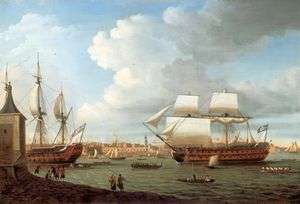Pégase-class ship of the line
The Pégase class was a class of 74-gun ships of the French Navy, built to a common design by naval constructor Antoine Groignard. It comprised six ships, all ordered during 1781 and all named on 13 July 1781.[3]
 Foudroyant and Pégase entering Portsmouth Harbour, 1782. Painting by Dominic Serres | |
| Class overview | |
|---|---|
| Name: | Pégase |
| Operators: | |
| Completed: | 6[1] |
| General characteristics | |
| Class and type: | Pégase class |
| Tons burthen: | 1500 tonnes[2] |
| Length: | 55.2 metres[2] |
| Beam: | 14.3 metres[2] |
| Draught: | 6.8 metres[2] |
| Propulsion: | Sails |
| Armament: |
|
The name-ship of the class - Pégase - was captured by the British Navy just two months after her completion; the other five ships were all at Toulon in August 1793 when that port was handed over by French Royalists to the occupying Anglo-Spanish forces, and they were seized by the British Navy. When French Republican forces forced the evacuation of the Allies in December, the Puissant was sailed to England (and - like the Pégase - was used as a harbour hulk there until the end of the Napoleonic Wars), and the Liberté (ex-Dictateur) and Suffisant were destroyed during the evacuation of the port; the remaining pair were recovered by the French Navy - see their respective individual histories below.
Ships
- Pégase[2]
- Builder: Brest Dockyard
- Ordered: June 1781
- Begun: June 1781
- Launched: 5 October 1781
- Completed: February 1782
- Fate: Captured by HMS Foudroyant in the Bay of Biscay on 21 April 1782 (with 80 men of her crew killed); renamed HMS Pegase; hulked 1794 at Plymouth, until broken up in 1815.
- Builder: Lorient Dockyard
- Ordered: 13 July 1781
- Begun: August 1781
- Launched: 13 March 1782
- Completed: June 1782
- Fate: Surrendered to the British by her Royalist crew during the Siege of Toulon on 29 September 1793; removed to England at the evacuation of the city; became a hulk in Portsmouth 1796; broken up in 1816.
- Builder: Toulon Dockyard
- Ordered: 13 July 1781
- Begun: July 1781
- Launched: 16 February 1782
- Completed: August 1782
- Fate: Renamed Liberté on 29 September 1792. Burnt at the end of the Siege of Toulon on 18 December 1793. Raised in 1805 and scrapped in 1808.
- Builder: Toulon Dockyard
- Ordered: 13 July 1781
- Begun: July 1781
- Launched: 6 March 1782
- Completed: August 1782
- Fate: Burnt at the end of the Siege of Toulon 18 December 1793. Raised in 1805 and scrapped in 1806.
- Alcide [7]
- Builder: Rochefort Dockyard
- Ordered: 13 July 1781
- Begun: July 1781
- Launched: 25 May 1782
- Completed: January 1783
- Fate: Burnt during the Battle of Hyères Islands on 18 July 1795 by her own heated shots, and exploded.
- Builder: Rochefort Dockyard
- Ordered: 13 July 1781
- Begun: August 1781
- Launched: 24 July 1782
- Completed: October 1783
- Fate: Captured by the British at the Battle of Cape Noli 14 March 1795; retaken in the Action of 7 October 1795 by de Richery's squadron off Cape St Vincent; sold at Cadiz to Spain in June 1799 in exchange for the Spanish San Sebastián.
Notes and references
Notes
References
- Roche, p.508
- Roche, p.344
- Winfield & Roberts, French Warships in the Age of Sail 1786-1861, p.86.
- Roche, p.368
- Roche, p.150
- Roche, p.424
- Roche, p.30-31
- Roche, p.103
Bibliography
- Roche, Jean-Michel (2005). Dictionnaire des bâtiments de la flotte de guerre française de Colbert à nos jours. 1. Group Retozel-Maury Millau. p. 280. ISBN 978-2-9525917-0-6. OCLC 165892922.
- Winfield, Rif and Roberts, Stephen S. (2017) French Warships in the Age of Sail 1626–1786: Design, Construction, Careers and Fates.. Seaforth Publishing, 2017. ISBN 978-1-4738-9351-1.
- Winfield, Rif and Roberts, Stephen S. (2015) French Warships in the Age of Sail 1786-1861: Design, Construction, Careers and Fates. Seaforth Publishing. ISBN 978-1-84832-204-2.